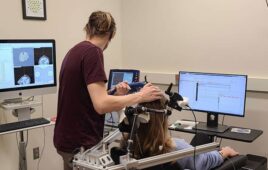New fundamental knowledge about the regulation of stem cells in the nerve tissue of zebrafish embryos results in surprising insights into neurodegenerative disease processes in the human brain. A new study by scientists at VIB and KU Leuven identifies the molecules responsible for this process.
Zebrafish as a Model
The zebrafish is a small fish measuring 3 to 5 cm in length, with dark stripes along the length of its body. They are originally from India, but also a popular aquarium fish. Zebrafish have several unusual characteristics that make them popular for scientific research. Zebrafish eggs are fertilized outside the body, where they develop into embryos. This process occurs very quickly: the most important organs have formed after 24 hours and the young fish have hatched after 3 days. These fish are initially transparent, making them easy to study under the microscope. Zebrafish start reproducing after only 3 months. The genetic code of humans and zebrafish is more than 90 % identical. In addition, the genetic material of these fish is easy to manipulate, meaning that they are often used as a model in the study of all sorts of diseases.
Stem Cells in the Brain
Evgenia Salta, scientist in the team of Bart De Strooper (VIB – KU Leuven), used zebrafish as a model in molecular brain research and discovered a previously unknown regulatory process for the development of nerve cells. Evgenia Salta explains: “The human brain contains stem cells, which are cells that have not matured into nerve cells yet, but do have the potential to do this.” Stem cells are of course crucial in the development of the brain. Similar stem cells also exist in zebrafish. Therefore, these fish form an ideal model to study the behavior of these cells. A so-called Notch signaling pathway regulates the further ripening of these cells during early embryonic development. Scientists are still largely in the dark about Notch processes in the brains of Alzheimer patients, but the research by Evgenia Salta is changing this situation.
MicroRNA
The expression of genes, which form the basis of the Notch signaling pathway, is regulated in part by microRNAs (miRNAs), which are short molecules that can inhibit or activate genes. Evgenia Salta: “We specifically studied how miRNA-132 regulates the Notch signaling pathway in stem cells.”
MiRNA-132 appears to play a role in maintaining the plasticity of the adult human brain. The adult brain still contains stem cells, but these are limited in number. The activity of miRNA-132 is reduced in diseases of the nervous system that involve the death of nerve cells, such as Alzheimer’s dementia. “We wanted to study the effect of the reduction in miRNA-132 in the nervous system. Zebrafish are an ideal model for this, because we can easily reduce levels of this miRNA in them. The development of stem cells is impaired in these altered fish. We mapped the molecules that play a role in this process”, explains Evgenia Salta.
Relevance
The concentration of miRNA-132 is also reduced in the brains of patients with Alzheimer’s disease. Therefore, the zebrafish allow you to mimic a condition that also occurs in Alzheimer’s dementia. Evgenia Salta: “To our surprise, the reduced activity of miRNA-132 in the zebrafish blocks the further ripening of stem cells into nerve cells. This new knowledge about the molecular signaling pathway that underlies this process gives us an insight into the exact blocking mechanism. Thanks to this work in zebrafish, we can now examine in detail what exactly goes wrong in the brains of patients with Alzheimer’s disease.” The research team has therefore started a follow-up study in mice and the brains of deceased patients.




